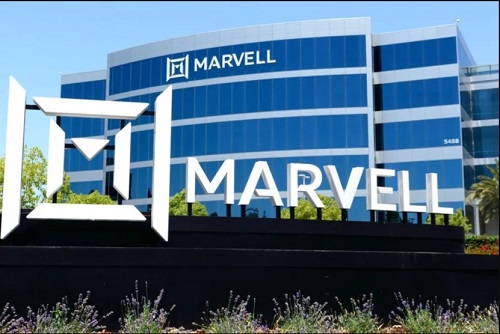Chipmaker Marvell Technology (MRVL) projected fourth-quarter revenue exceeding expectations on Tuesday, driven by strong demand for its specialized artificial intelligence chips from companies eager to build the most advanced generative AI models.
The shares of the Santa Clara, California-based firm jumped over 8% in after-hours trading following the news. During Tuesday’s trading session, the stock reached an all-time high.
Marvell’s stock has increased nearly 60% this year as investors on Wall Street have heavily favored the surge in demand for sophisticated chips that can handle the complex processing requirements of generative AI.
Shares of its larger rival Broadcom have appreciated approximately 50% in 2023.
Marvell projected fourth-quarter revenue of $1.80 billion, with a margin of error of 5%, compared to the analysts’ average prediction of $1.65 billion, based on data gathered by LSEG.
Although Nvidia dominates the AI processor market, major tech firms have been striving to lessen their reliance on the chip leader’s supply-limited semiconductors, which has provided a boost to companies like Marvell.
Marvell aids major cloud computing firms in creating custom-designed processors.
The company began exploring the development of customized chips for large-scale data center operators in 2020 and has rapidly expanded this division into a major revenue source for the organization, as stated by Marvell Chief Operations Officer Chris Koopmans in an interview.
“This initiative we have been working on for years has finally materialized,” Koopmans remarked.
The overall market for custom chips could expand to approximately $45 billion by 2028 and will likely be divided between Marvell and Broadcom, Koopmans mentioned.
Research firm 650 Group’s Alan Weckel estimates that the custom chip market for data centers will grow to nearly $10 billion this year.
Revenue in Marvell’s data center division doubled to $1.10 billion in the third quarter compared to the prior year. The total revenue for the quarter was $1.52 billion, surpassing the expected $1.46 billion.
In April, the company anticipated that its AI chip sales would reach $2.5 billion by the fiscal year 2026.
Analysts at Jefferies forecast that revenue solely from custom AI chips could be between $2.5 billion and $3 billion in 2025, with additional optical equipment contributing another $1.5 billion to $2 billion to AI revenue, according to a note published in October.
As the AI chip market expands, clients in other sectors served by the company, such as wireless carriers, are reducing chip inventories after overbuying during the pandemic.
Marvell’s enterprise networking segment saw a 44% decline in revenue to $150.9 million, while its carrier infrastructure revenue dropped 73% to $84.7 million.
The company predicted an adjusted gross margin of 60% for the fourth quarter, slightly below estimates of 61%. Custom chips usually have lower margins compared to off-the-shelf products.
The firm reported adjusted earnings of 43 cents per share in the third quarter, exceeding the forecast of 41 cents.
Can Marvell Achieve Profitability While Aiming to Triple Its Business by 2028?
An overall increase may benefit all companies, which is a positive development for any business involved with AI. However, the key question remains whether this growth will translate into profitable outcomes.
So far, depending on how skeptical one might be regarding the server downturn and competitive pressures across the compute, networking, and storage sectors, only one company has managed to leverage the AI wave effectively to generate substantial profits. This company is literally keeping Wall Street buoyant at the moment, which is Nvidia.
Nonetheless, other companies are eager to try; among them is Marvell Technology, which boasts a longer track record in the semiconductor domain within data centers than even Nvidia.
Marvell stands a better chance than many chip and systems manufacturers to take advantage of the vast generative AI opportunity in the coming years.
We have followed Marvell’s diverse technologies for several years now, paying special attention to the Cavium Arm server CPU business and the Innovium Ethernet switch ASIC business before they were acquired by Marvell to enhance its data center computing and networking aspirations.
Marvell’s well-respected Armada Arm chips initiated the Arm server revolution, likely unintentionally, around 2009, and we have tracked developments since. Marvell acquired Cavium in November 2017 for $6.1 billion to acquire its ThunderX family of Arm chips and Innovium in August 2021 for $1.1 billion, securing its hyperscaler-focused Teralynx switch chips.
However, Marvell is not merely in the chip-selling business; it is fundamentally providing expertise to help others design their chips and guide them through the production facilities of Taiwan Semiconductor Manufacturing Co, and presumably, when necessary, those of Samsung and Intel as they begin offering competitive alternatives.
The $650 million acquisition of Avera Semiconductor, which is a combination of the chip design teams from GlobalFoundries and IBM, underscores this strategy.
In September 2020, we conducted an in-depth analysis of the custom and semi-custom chip sector at Marvell, and now we will begin monitoring Marvell’s financial performance, as many believe the company can compete with Nvidia, AMD, Intel, Cisco Systems, and Broadcom in the areas of compute, storage, and networking, while also collaborating with them to adapt technologies aimed at reducing the costs of GenAI systems and taking on Nvidia’s dominance in AI hardware and software.
With the inclusion of DSPs and optical modules from the $10 billion Inphi acquisition completed in October 2020, Marvell enhanced its datacenter and 5G interconnect operations and complemented its existing Prestera and future Innovium Ethernet switching products.
Many components are in place for Marvell to gain from a significant restructuring of the datacenter to support AI workloads, at a notable expense of $17.9 billion in cash and stock through those four acquisitions. The assembly of datacenter technologies that Marvell has coordinated is purposeful, and the datacenter sector is on an upward trend. However, as demonstrated by its latest financial outcomes, tangible results are not yet evident in its P&Ls.
During its first quarter of fiscal 2025, which concluded in early May, Marvell reported a revenue drop of 12.2 percent to $1.16 billion, reflecting an 18.6 percent decline sequentially from the prior quarter of fiscal 2024, which ended on February 3. The operations led to a loss of $152 million, with a reported net loss of $215.6 million. The company held $848 million in cash and had just over $4 billion in long-term debt.
The recent quarter losses have raised concerns, making it challenging to determine whether these are a result of decreasing sales in traditional datacenter compute, storage, and interconnect sectors, or if the growing custom silicon business Marvell is doing with hyperscalers and cloud builders, getting it produced through TSMC foundries on cutting-edge processes, is negatively impacting profitability. Similar to other chip manufacturers and system builders, it is difficult to ascertain because they do not disclose specifics about the profitability of their AI-related ventures. However, it certainly appears that Hewlett Packard Enterprise, Dell, Lenovo, Cisco Systems, and Supermicro are facing difficulties in achieving profits from their expanding AI operations.
In the quarter, Marvell’s Datacenter segment reported sales of $816.4 million, an increase by a factor of 1.87 compared to the same period last year and a 6.7 percent rise sequentially. Matt Murphy, Marvell’s president and CEO, indicated during a discussion with Wall Street analysts that substantial growth from the “cloud” segment more than compensated for a “higher than seasonal decline” in chips sold for products targeted at enterprise, on-premises datacenters.
Revenues for the fiscal period saw significant enhancement due to initial shipments of custom accelerators for hyperscalers and cloud providers. Several years back, AI chip startup Groq collaborated with Marvell to assist in designing and producing its TSP accelerators, and now Marvell has partnerships for design and manufacturing with three out of the four major hyperscalers and cloud providers in the United States.
While Marvell does not disclose specific names associated with these devices, it is widely believed that the latest Trainium2 AI training chips from Amazon Web Services are currently ramping up production with Marvell and TSMC, with future Inferentia3 AI inference chips expected to ramp in 2025. (These Inferentia3 chips have not yet been announced but may be revealed shortly.) Google’s “Cypress” Axion Arm server chips also appear to be emerging with Marvell’s assistance and are currently ramping. Additionally, Microsoft is reportedly collaborating with Marvell for an upcoming version of its “Athena” Maia series of AI accelerators, anticipated to ramp up in 2026. (These may be informally referred to as Athena2 and categorized as the Maia 200 series during production.) Microsoft introduced the Maia 100 series alongside their corresponding Cobalt 100 series Arm server CPUs in November 2023.
The growth of Marvell’s Datacenter group is being driven by custom silicon partnerships with hyperscalers and cloud providers, along with their uptake of networking and interconnect solutions. Murphy expressed during the call that revenues for this segment are projected to rise “in the mid-single digits” sequentially in fiscal Q2. The company has developed a range of coherent DSPs utilized as the foundation for datacenter interconnects (DCI) that can extend up to 1,000 kilometers, and these are expected to generate a $1 billion business over the long term, with the overall DCI market projected to grow to $3 billion by the end of calendar 2028. Marvell’s PAM-4 DSPs are also being embraced by hyperscalers and cloud providers and are expected to contribute an additional $1 billion in revenue over a similarly extended period. (Again, presumably by 2028.)
Marvell has recently ventured into the PCI-Express retimer chip market, competing with Astera Labs, which believed it would dominate this sector until Broadcom reentered it this year, followed by Marvell’s entry. These retimer chips facilitate the connection between flash storage, accelerators, and PCI-Express controllers embedded in host CPUs.
“We perceive a significant opportunity approaching with the data center TAM predicted to rise from $21 billion last year to $75 billion by calendar 2028 at a 29 percent CAGR,” Murphy stated during the Wall Street call. “We identify numerous prospects across compute, interconnect, switching, and storage, hence we anticipate doubling our market share over the coming years from our approximately 10 percent share last fiscal year.”
These figures align with Marvell’s discussions at its accelerated infrastructure event earlier this year, which we could not attend due to medical issues at home, but from which we are extracting information for this analysis.
At its AI Era event in April, Marvell reported approximately $200 million in AI-related connectivity sales for fiscal 2023, which is projected to exceed $550 million in fiscal 2024. In fiscal 2025, the current fiscal year, Marvell expects its connectivity and custom compute sectors to drive over $1.5 billion in sales (roughly a $1 billion increase) and anticipates AI revenues to contribute an additional $1 billion or more in fiscal 2026, surpassing $2.5 billion.
It is useful to contextualize this and the overall trends for Marvell with broader data. Below is how Marvell views the datacenter semiconductor total addressable market (TAM), starting from the baseline of calendar 2023.
According to various sources, Marvell estimates that global datacenter capital expenditures were around $260 billion in 2023. Out of that, $197 billion was allocated for IT equipment, excluding the physical datacenter infrastructure that supports and cools that IT equipment. Within this $197 billion earmarked for equipment, approximately $120 billion was spent on semiconductor chips, leading to a reduction in the datacenter TAM to roughly $82 billion when excluding different types of memory and other chips not covered by Marvell’s products.
The majority of this expenditure is for compute, and this revenue distribution reflects the architecture of distributed computing systems. That pie chart on the right could essentially represent a bill of materials cost for an HPC or AI cluster.
To delve deeper into the compute category, Marvell and its analysts believe that around $26 billion in general-purpose compute was sold in 2023, alongside about $42 billion in accelerated compute — including GPUs, TPUs, and other types of parallel accelerators frequently mentioned — making up a total of $68 billion. Looking toward calendar 2028, Marvell and its consultants expect the compute market to grow at a compound annual growth rate of 24 percent, reaching $202 billion, with general-purpose compute seeing a CAGR of 3 percent to hit $30 billion by 2028, while accelerated compute is projected to grow at a CAGR of 32 percent to reach $172 billion by 2028.
Within those compute figures, custom accelerated compute engines made up 16 percent of total accelerated compute in 2023, amounting to approximately $6.6 billion. Depending on varying estimates from Marvell’s sources, this sector is expected to grow at a CAGR of 32 percent to $27.5 billion while maintaining a 16 percent share of the total or at a CAGR of 45 percent between 2023 and 2028 to $42.9 billion, representing about 25 percent of the total.
Over the period of our financial evaluation, which spans from the February 2008 quarter through the May 2024 quarter, Marvell has reported $53.63 billion in sales, alongside only $1.99 billion in net income, equating to 3.7 percent of revenue. Additionally, the company has experienced extended periods of financial losses. We understand the reasons for this, and we commend the company for continuously reinventing itself to tackle new markets and for making acquisitions to solidify new foundations. However, the demands of hyperscaler and cloud builder clients can be considerable, leaving minimal profit margins for their partners. If Nvidia reduces its prices, it could undercut numerous homegrown accelerator initiatives. Similarly, Intel, AMD, and the Arm collective could follow suit with CPUs, reducing the appeal of proprietary CPUs.
We are skeptical that this will occur. It seems more probable that hyperscalers and cloud builders will aim to govern their own futures and utilize homegrown chips as leverage. Consequently, there is a potential for Marvell to benefit from these developments.



